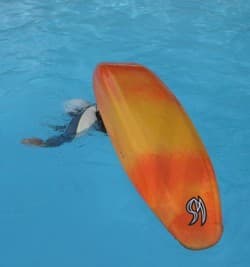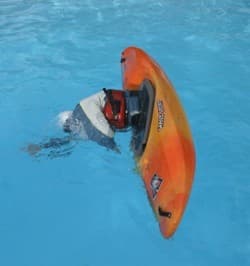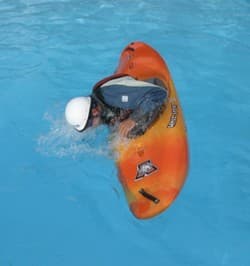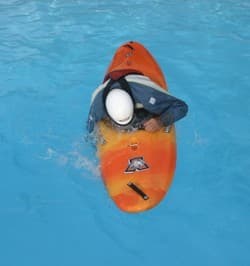The Hand Roll
The hand roll is a roll done without the help of a paddle: a move that requires solid rolling technique and an effective hip snap. The hand roll is a great move to master for a number of reasons. Most importantly, it's a confidence booster and if you haven't figured it out by now, whitewater kayaking is as much about confidence as it is about skill. Once you learn the hand roll, you might even find that it becomes your preferred roll. Through my first few years of paddling I would sometimes let go of my paddle underwater and hand roll myself up. I did this is because it was quicker to set-up underwater without the paddle and I knew I could get up just as reliably using my hand roll. Of course this left me without paddle in the middle of a rapid, but that was of secondary concern at the time. I got by like this in class 2/3 whitewater, but I knew this approach wasn't going to work as the whitewater got more adventuresome and more continuous. Without knowing it at the time, this caused me to develop my back deck roll technique, which is still the rolling technique I use 99% of the time… but that's another story.
We're going to look at the hand roll with the assumption that you already have a roll, or at least a clear understanding of how the roll works. I've broken the roll down into three unique parts; the set-up, the initiation, and the finish/recovery.


50 years of lightweight, maneuverable, high-performing kayaks.
Check out this interview with Tom Keane, Eddyline Kayaks Co-Owner, on their journey!
The idea behind the set-up of the hand roll is the same as that for a standard roll. You need to get your body out as far to the side of the kayak and as close to the surface as possible so that your hip snap can be most effective. Though the concept is the same, the position of your body is quite different from the standard roll. For the hand roll, you'll lean out to the side with your head and chest facing downward instead of up towards the sky. Your arms should be up and in front of your face. As most paddlers are stronger rolling up on their left side, this will mean leaning out to the left with our left arm being closest to the bow of the boat.
Though there are a couple of ways to initiate the hand roll, we're going to look at the double pump technique, which involves using one arm at a time in a two step process that resembles the climbing of a ladder. The first step involves pushing down on the water with the left hand, which provides the purchase necessary to start snapping the boat upright with your hips. As soon as this hand begins loosing effectiveness, reach out and push downward with your right hand and continue to rotate the boat upright. Of course it goes without saying that your head must stay down throughout these motions.
As you begin sweeping downward with the second hand you've reached the recovery phase of the roll and it's time to swing your body back over top the kayak. Whether to swing your body over the front or over the back of the boat is a topic of great debate. My recommendation is to simply use the technique that works most reliably in getting you upright. Whichever direction you swing your body up, keep your weight as close to the boat as possible.


The reason I find this double pump technique most effective is because it gives your hips a longer time to roll the boat underneath your body than a single, double-handed slap against the water. It also helps force a paddler to keep their head down throughout the roll and provides a clear landmark for timing when the body should swing up on top of the kayak.
The hand roll is a great skill to practice in an indoor pool during the winter months. Once you've nailed it then in the summer you can leave your paddle on shore at times and practice cool new things that will dramatically improve your overall paddling. Try some eddy turns and quick s-turns on a clean eddy line, or try surfing and spinning in small holes. You'll become more aware of your body's position over your kayak and of how to let the river do more of the work for you, which will ultimately open the door to the moves you've only dreamed about.
Ken Whiting was the 1997/98 World Whitewater Freestyle Champion. He has produced an award-winning series of instructional kayaking books and DVDs, and leads kayaking trips to Chile. Look for his latest book 'The Ultimate Guide to Whitewater Kayaking', and video 'The Ultimate Guide to Sea Kayaking'. Check out www.helipress.com
Related Articles
Even though they are flipping over, missing their gates and failing their maneuvers, they still look…
This recovery is an excellent example of using components from two traditional recovery techniques and…
There are two ways of swimming through a rapid. You can swim defensively or offensively. Defensive…
Watch this short tutorial video on the Continuous Greenland Roll with useful underwater shots and a…




